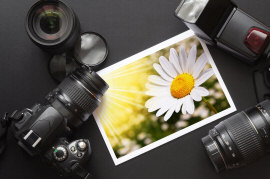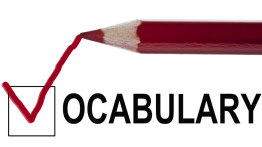*** This article I have written some years ago was originally published here.
Pictures Paint a Thousand Words
 Writing is considered the most difficult language skill to master, so instilling this interest to ESL students is twice as challenging. With the need to use correct expressions following the standard conventions of grammar and compositions, students whose first language is not English might grasp for words to complete a single sentence expressing what was required to be written. It should be remembered, however, that when topics are directly connected with our interests, it is easier to write.Students are motivated to give their best, expressing thoughts on paper, when they are given the chance to write about something they know deeply or have experienced personally. It is necessary that teachers should devise ways on how to make writing classes engaging. Instead of compelling students to write on generic ideas, make use of significant events in their lives to produce excellent compositions.
Writing is considered the most difficult language skill to master, so instilling this interest to ESL students is twice as challenging. With the need to use correct expressions following the standard conventions of grammar and compositions, students whose first language is not English might grasp for words to complete a single sentence expressing what was required to be written. It should be remembered, however, that when topics are directly connected with our interests, it is easier to write.Students are motivated to give their best, expressing thoughts on paper, when they are given the chance to write about something they know deeply or have experienced personally. It is necessary that teachers should devise ways on how to make writing classes engaging. Instead of compelling students to write on generic ideas, make use of significant events in their lives to produce excellent compositions.
 Writing is considered the most difficult language skill to master, so instilling this interest to ESL students is twice as challenging. With the need to use correct expressions following the standard conventions of grammar and compositions, students whose first language is not English might grasp for words to complete a single sentence expressing what was required to be written. It should be remembered, however, that when topics are directly connected with our interests, it is easier to write.Students are motivated to give their best, expressing thoughts on paper, when they are given the chance to write about something they know deeply or have experienced personally. It is necessary that teachers should devise ways on how to make writing classes engaging. Instead of compelling students to write on generic ideas, make use of significant events in their lives to produce excellent compositions.
Writing is considered the most difficult language skill to master, so instilling this interest to ESL students is twice as challenging. With the need to use correct expressions following the standard conventions of grammar and compositions, students whose first language is not English might grasp for words to complete a single sentence expressing what was required to be written. It should be remembered, however, that when topics are directly connected with our interests, it is easier to write.Students are motivated to give their best, expressing thoughts on paper, when they are given the chance to write about something they know deeply or have experienced personally. It is necessary that teachers should devise ways on how to make writing classes engaging. Instead of compelling students to write on generic ideas, make use of significant events in their lives to produce excellent compositions.
For many English as a second language students, writing about their recent trips or picnics are easily accomplished as they have firsthand experience to jot on a page. Celebrations in the family can also be a good inspiration for writing. Additionally, these events can be commemorated by photographs serving as memoirs of significant periods of life. In the same light, photos help people remember details about places they’ve been to, people we shared good moments with, and events that made our lives happier. In other words, they are colorful and powerful narratives that can trigger students’ interests to convert them into powerful lines and stories.
Writing and the Teacher’s Role
 The types of teaching strategies employed in the classroom are manifestations of the teacher’s belief. Articulated or not, they always play an important role in the way the class is carried and led to the achievement of goals. Our beliefs as educators affect our choice of resources, assessment and organization of class activities. No matter how different the beliefs may be, teachers should ensure that writing classes are made fun and interesting.
The types of teaching strategies employed in the classroom are manifestations of the teacher’s belief. Articulated or not, they always play an important role in the way the class is carried and led to the achievement of goals. Our beliefs as educators affect our choice of resources, assessment and organization of class activities. No matter how different the beliefs may be, teachers should ensure that writing classes are made fun and interesting.
 The types of teaching strategies employed in the classroom are manifestations of the teacher’s belief. Articulated or not, they always play an important role in the way the class is carried and led to the achievement of goals. Our beliefs as educators affect our choice of resources, assessment and organization of class activities. No matter how different the beliefs may be, teachers should ensure that writing classes are made fun and interesting.
The types of teaching strategies employed in the classroom are manifestations of the teacher’s belief. Articulated or not, they always play an important role in the way the class is carried and led to the achievement of goals. Our beliefs as educators affect our choice of resources, assessment and organization of class activities. No matter how different the beliefs may be, teachers should ensure that writing classes are made fun and interesting.
It should be kept in mind that teachers are the instruments in making students understand that like all language skills, writing follows the same rules on semantics and syntax. There are some important considerations to observe in our writing classes. First, they should provide opportunities for students to brainstorm on ideas through talking or listening before they write. This will help students direct their focus and get the sense for writing. Secondly, writing activities can be linked to reading. This is because articles students are exposed to can be used as models for writing styles, providing definite examples of how information can be arranged or structured according to what was perceived to be significant in the composition. Simply put, it shows students what good writing is like. Third and equally important, it should be part of practice to give students the opportunities to share or choose their source of inspiration for writing compositions.
As ESL writers start to brainstorm ideas for their composition, they should include their peers to add different points of view and ideas to their writing. The topics chosen and the way sentences are crafted to create the desired message do not only show possible potential writers but also gives leeway for class members to learn from less anxiety inducing sources.
As ESL writers start to brainstorm ideas for their composition, they should include their peers to add different points of view and ideas to their writing. The topics chosen and the way sentences are crafted to create the desired message do not only show possible potential writers but also gives leeway for class members to learn from less anxiety inducing sources.
The following are the ways to help to inspire writers with the use of photos in class:
1) Require a Favorite Family or Personal Photo
 Students are to be asked to bring to class their favorite photos or set of photos. With this, it is sure that students picked what they think is the most interesting and, thus, will be able to share views or stories based on them. Remember that visuals are powerful in providing context for any writing pieces and students can easily start writing a topic that sparks their attention or curiosity. Because it was a free choice to bring any picture, perhaps students chose it for being stimulating and attractive. In addition, since it is something they brought from home, they are knowledgeable about the place, time, event and people in captured in print. As students take hold of their favorite photo, ask them to look for details they may want to use as the main idea for writing. Prompt them to look for something interesting or funny, to spot things that are colorful, or to describe shapes or facial expressions.
Students are to be asked to bring to class their favorite photos or set of photos. With this, it is sure that students picked what they think is the most interesting and, thus, will be able to share views or stories based on them. Remember that visuals are powerful in providing context for any writing pieces and students can easily start writing a topic that sparks their attention or curiosity. Because it was a free choice to bring any picture, perhaps students chose it for being stimulating and attractive. In addition, since it is something they brought from home, they are knowledgeable about the place, time, event and people in captured in print. As students take hold of their favorite photo, ask them to look for details they may want to use as the main idea for writing. Prompt them to look for something interesting or funny, to spot things that are colorful, or to describe shapes or facial expressions.
 Students are to be asked to bring to class their favorite photos or set of photos. With this, it is sure that students picked what they think is the most interesting and, thus, will be able to share views or stories based on them. Remember that visuals are powerful in providing context for any writing pieces and students can easily start writing a topic that sparks their attention or curiosity. Because it was a free choice to bring any picture, perhaps students chose it for being stimulating and attractive. In addition, since it is something they brought from home, they are knowledgeable about the place, time, event and people in captured in print. As students take hold of their favorite photo, ask them to look for details they may want to use as the main idea for writing. Prompt them to look for something interesting or funny, to spot things that are colorful, or to describe shapes or facial expressions.
Students are to be asked to bring to class their favorite photos or set of photos. With this, it is sure that students picked what they think is the most interesting and, thus, will be able to share views or stories based on them. Remember that visuals are powerful in providing context for any writing pieces and students can easily start writing a topic that sparks their attention or curiosity. Because it was a free choice to bring any picture, perhaps students chose it for being stimulating and attractive. In addition, since it is something they brought from home, they are knowledgeable about the place, time, event and people in captured in print. As students take hold of their favorite photo, ask them to look for details they may want to use as the main idea for writing. Prompt them to look for something interesting or funny, to spot things that are colorful, or to describe shapes or facial expressions.
Consequently, you can ask class members to swap photos with a friend. When students bring in pictures for class, they may not only find pleasure looking at their memorable smiles or travels but they might also provide themselves with writing ideas they never knew possible. To add more challenge to this, ask students to swap pictures with their peers. Doing this will test how well they think of main ideas as they may not know the people in the pictures, or the place and time they were taken. This, however, will develop their skills in writing conventions and objectivity in compositions.
2) Scaffold Ideas About the Photo
 Students asking teachers for translation, vocabulary or possible main ideas is a typical scene in ESL writing classes. With students having the ideas as inspired by their photos, the challenge comes with decoding the message in the pictures and converting them into excellent write-ups. As a teacher, being able to provide the correct information for the student is fulfilling yet tiring. Despite its difficulty, it should be noted that students must exert twice or thrice the effort to express what they want to say. Scaffolding is a helpful strategy in writing classes as it helps break up complex tasks into smaller, simpler pieces of information. Additionally, it gives teachers the chance to intervene with the students’ work and lessen, if not totally eliminate, misunderstanding of concepts and difficulties in following formal writing conventions. Because second language learners may not have enough knowledge of the topics or the rules, they are facing the trial of getting into the unknown. No matter how simple rules or words may be, this isn’t the case for many ESL students, especially those who are beginners or approaching intermediate levels. Typically, they have limited ideas on how writing should be like, how it should be organized, or how to make writings understandable to readers. When left on their own, they are bound to miss the standards. With your students holding their favorite picture, take time to ask them what they can see and which would they want to write about or would like others to know.
Students asking teachers for translation, vocabulary or possible main ideas is a typical scene in ESL writing classes. With students having the ideas as inspired by their photos, the challenge comes with decoding the message in the pictures and converting them into excellent write-ups. As a teacher, being able to provide the correct information for the student is fulfilling yet tiring. Despite its difficulty, it should be noted that students must exert twice or thrice the effort to express what they want to say. Scaffolding is a helpful strategy in writing classes as it helps break up complex tasks into smaller, simpler pieces of information. Additionally, it gives teachers the chance to intervene with the students’ work and lessen, if not totally eliminate, misunderstanding of concepts and difficulties in following formal writing conventions. Because second language learners may not have enough knowledge of the topics or the rules, they are facing the trial of getting into the unknown. No matter how simple rules or words may be, this isn’t the case for many ESL students, especially those who are beginners or approaching intermediate levels. Typically, they have limited ideas on how writing should be like, how it should be organized, or how to make writings understandable to readers. When left on their own, they are bound to miss the standards. With your students holding their favorite picture, take time to ask them what they can see and which would they want to write about or would like others to know.
 Students asking teachers for translation, vocabulary or possible main ideas is a typical scene in ESL writing classes. With students having the ideas as inspired by their photos, the challenge comes with decoding the message in the pictures and converting them into excellent write-ups. As a teacher, being able to provide the correct information for the student is fulfilling yet tiring. Despite its difficulty, it should be noted that students must exert twice or thrice the effort to express what they want to say. Scaffolding is a helpful strategy in writing classes as it helps break up complex tasks into smaller, simpler pieces of information. Additionally, it gives teachers the chance to intervene with the students’ work and lessen, if not totally eliminate, misunderstanding of concepts and difficulties in following formal writing conventions. Because second language learners may not have enough knowledge of the topics or the rules, they are facing the trial of getting into the unknown. No matter how simple rules or words may be, this isn’t the case for many ESL students, especially those who are beginners or approaching intermediate levels. Typically, they have limited ideas on how writing should be like, how it should be organized, or how to make writings understandable to readers. When left on their own, they are bound to miss the standards. With your students holding their favorite picture, take time to ask them what they can see and which would they want to write about or would like others to know.
Students asking teachers for translation, vocabulary or possible main ideas is a typical scene in ESL writing classes. With students having the ideas as inspired by their photos, the challenge comes with decoding the message in the pictures and converting them into excellent write-ups. As a teacher, being able to provide the correct information for the student is fulfilling yet tiring. Despite its difficulty, it should be noted that students must exert twice or thrice the effort to express what they want to say. Scaffolding is a helpful strategy in writing classes as it helps break up complex tasks into smaller, simpler pieces of information. Additionally, it gives teachers the chance to intervene with the students’ work and lessen, if not totally eliminate, misunderstanding of concepts and difficulties in following formal writing conventions. Because second language learners may not have enough knowledge of the topics or the rules, they are facing the trial of getting into the unknown. No matter how simple rules or words may be, this isn’t the case for many ESL students, especially those who are beginners or approaching intermediate levels. Typically, they have limited ideas on how writing should be like, how it should be organized, or how to make writings understandable to readers. When left on their own, they are bound to miss the standards. With your students holding their favorite picture, take time to ask them what they can see and which would they want to write about or would like others to know.
3) Building Vocabulary List From Pictures
 They said that a good mechanic always has his toolbox full of essential tools. Writers have the need for this toolbox in the form of vocabulary, punctuation, and grammar. Some tools are used more frequently than others, but the box is to be filled with new ones regularly. Writers need to make use of the tools in the box to make writing more powerful and compelling. This is where the need for vocabulary comes in. Students can never write with limited set of words, and with the teacher’s help, this can be augmented. With the picture in hand, struggling students can be supported while helping them think. Teachers can ask questions like the 5ws (what, when, where, why, who) and the 1h (how) to help find words for the sentences. Instead of readily providing the student with words, they can be asked for the names, shapes, color or location of things found on the photo. As they arrive at answers, make them create a list, so there are words to be included in their writings. You can also require students to bring dictionary with words from their native language to English or the other way around. As they progress on their vocabulary work, encourage them to use only the English dictionary. Because ESL students tend to choose the more difficult synonym of a word, they might convey different meanings. This is where teachers can now explain the importance of correct choice of words.
They said that a good mechanic always has his toolbox full of essential tools. Writers have the need for this toolbox in the form of vocabulary, punctuation, and grammar. Some tools are used more frequently than others, but the box is to be filled with new ones regularly. Writers need to make use of the tools in the box to make writing more powerful and compelling. This is where the need for vocabulary comes in. Students can never write with limited set of words, and with the teacher’s help, this can be augmented. With the picture in hand, struggling students can be supported while helping them think. Teachers can ask questions like the 5ws (what, when, where, why, who) and the 1h (how) to help find words for the sentences. Instead of readily providing the student with words, they can be asked for the names, shapes, color or location of things found on the photo. As they arrive at answers, make them create a list, so there are words to be included in their writings. You can also require students to bring dictionary with words from their native language to English or the other way around. As they progress on their vocabulary work, encourage them to use only the English dictionary. Because ESL students tend to choose the more difficult synonym of a word, they might convey different meanings. This is where teachers can now explain the importance of correct choice of words.
 They said that a good mechanic always has his toolbox full of essential tools. Writers have the need for this toolbox in the form of vocabulary, punctuation, and grammar. Some tools are used more frequently than others, but the box is to be filled with new ones regularly. Writers need to make use of the tools in the box to make writing more powerful and compelling. This is where the need for vocabulary comes in. Students can never write with limited set of words, and with the teacher’s help, this can be augmented. With the picture in hand, struggling students can be supported while helping them think. Teachers can ask questions like the 5ws (what, when, where, why, who) and the 1h (how) to help find words for the sentences. Instead of readily providing the student with words, they can be asked for the names, shapes, color or location of things found on the photo. As they arrive at answers, make them create a list, so there are words to be included in their writings. You can also require students to bring dictionary with words from their native language to English or the other way around. As they progress on their vocabulary work, encourage them to use only the English dictionary. Because ESL students tend to choose the more difficult synonym of a word, they might convey different meanings. This is where teachers can now explain the importance of correct choice of words.
They said that a good mechanic always has his toolbox full of essential tools. Writers have the need for this toolbox in the form of vocabulary, punctuation, and grammar. Some tools are used more frequently than others, but the box is to be filled with new ones regularly. Writers need to make use of the tools in the box to make writing more powerful and compelling. This is where the need for vocabulary comes in. Students can never write with limited set of words, and with the teacher’s help, this can be augmented. With the picture in hand, struggling students can be supported while helping them think. Teachers can ask questions like the 5ws (what, when, where, why, who) and the 1h (how) to help find words for the sentences. Instead of readily providing the student with words, they can be asked for the names, shapes, color or location of things found on the photo. As they arrive at answers, make them create a list, so there are words to be included in their writings. You can also require students to bring dictionary with words from their native language to English or the other way around. As they progress on their vocabulary work, encourage them to use only the English dictionary. Because ESL students tend to choose the more difficult synonym of a word, they might convey different meanings. This is where teachers can now explain the importance of correct choice of words.
4) Compare and Contrast People or Things in the Picture
 Perhaps one of the most interesting challenges for students in writing classes is the task to find what they think are the differences among the subjects of the photo. If students find it difficult to choose ideas for their writing, ask them to find at least five or ten differences among people or things in the picture. If they are the owner of the photos, they might as well be triggered to look closely as they know the people or things in the image. This activity will help your students develop accuracy in descriptions and make use of the vocabulary they listed. Alternately, when there are limited elements to contrast, you can let them compare. This is where they can make use of descriptions like colors, shapes, sizes, actions, directions and so on. When the students are able to do the first two tasks with ease, challenge them to compare and contrast elements in a single write-up. Making students do these exercises will help develop the ability to analyze likeness and differences while keeping in mind that one description can’t go without the other. To make even easier for students, encourage them to make use of a graphic organizer like a Venn diagram to visualize and organize ideas more clearly.
Perhaps one of the most interesting challenges for students in writing classes is the task to find what they think are the differences among the subjects of the photo. If students find it difficult to choose ideas for their writing, ask them to find at least five or ten differences among people or things in the picture. If they are the owner of the photos, they might as well be triggered to look closely as they know the people or things in the image. This activity will help your students develop accuracy in descriptions and make use of the vocabulary they listed. Alternately, when there are limited elements to contrast, you can let them compare. This is where they can make use of descriptions like colors, shapes, sizes, actions, directions and so on. When the students are able to do the first two tasks with ease, challenge them to compare and contrast elements in a single write-up. Making students do these exercises will help develop the ability to analyze likeness and differences while keeping in mind that one description can’t go without the other. To make even easier for students, encourage them to make use of a graphic organizer like a Venn diagram to visualize and organize ideas more clearly.
 Perhaps one of the most interesting challenges for students in writing classes is the task to find what they think are the differences among the subjects of the photo. If students find it difficult to choose ideas for their writing, ask them to find at least five or ten differences among people or things in the picture. If they are the owner of the photos, they might as well be triggered to look closely as they know the people or things in the image. This activity will help your students develop accuracy in descriptions and make use of the vocabulary they listed. Alternately, when there are limited elements to contrast, you can let them compare. This is where they can make use of descriptions like colors, shapes, sizes, actions, directions and so on. When the students are able to do the first two tasks with ease, challenge them to compare and contrast elements in a single write-up. Making students do these exercises will help develop the ability to analyze likeness and differences while keeping in mind that one description can’t go without the other. To make even easier for students, encourage them to make use of a graphic organizer like a Venn diagram to visualize and organize ideas more clearly.
Perhaps one of the most interesting challenges for students in writing classes is the task to find what they think are the differences among the subjects of the photo. If students find it difficult to choose ideas for their writing, ask them to find at least five or ten differences among people or things in the picture. If they are the owner of the photos, they might as well be triggered to look closely as they know the people or things in the image. This activity will help your students develop accuracy in descriptions and make use of the vocabulary they listed. Alternately, when there are limited elements to contrast, you can let them compare. This is where they can make use of descriptions like colors, shapes, sizes, actions, directions and so on. When the students are able to do the first two tasks with ease, challenge them to compare and contrast elements in a single write-up. Making students do these exercises will help develop the ability to analyze likeness and differences while keeping in mind that one description can’t go without the other. To make even easier for students, encourage them to make use of a graphic organizer like a Venn diagram to visualize and organize ideas more clearly.
5) Expressing Conditions Based on the Picture
 Yes, pictures can be used to help students find good writing ideas and to review them on grammar rules. Another way in making students produce good compositions is to use pictures as a springboard for main ideas. Instead of asking them to just describe it plainly, you can trigger their imagination by giving them prompts like, “If I were here…” or asking them questions like, “What would you be doing if you were/weren’t in the scene?” As students are holding on to their favorite photo of landscape, park, party or overseas travel, they would think of possibilities and would be compelled to imagine what’s otherwise. Equally important, they would be pushed onto making sentences expressing conditions, making use of their prior knowledge from grammar lectures. Additionally, asking students to come up with ideas opposite to what they can see directly will enhance their imagination- a very important skill in creating great compositions.
Yes, pictures can be used to help students find good writing ideas and to review them on grammar rules. Another way in making students produce good compositions is to use pictures as a springboard for main ideas. Instead of asking them to just describe it plainly, you can trigger their imagination by giving them prompts like, “If I were here…” or asking them questions like, “What would you be doing if you were/weren’t in the scene?” As students are holding on to their favorite photo of landscape, park, party or overseas travel, they would think of possibilities and would be compelled to imagine what’s otherwise. Equally important, they would be pushed onto making sentences expressing conditions, making use of their prior knowledge from grammar lectures. Additionally, asking students to come up with ideas opposite to what they can see directly will enhance their imagination- a very important skill in creating great compositions.
 Yes, pictures can be used to help students find good writing ideas and to review them on grammar rules. Another way in making students produce good compositions is to use pictures as a springboard for main ideas. Instead of asking them to just describe it plainly, you can trigger their imagination by giving them prompts like, “If I were here…” or asking them questions like, “What would you be doing if you were/weren’t in the scene?” As students are holding on to their favorite photo of landscape, park, party or overseas travel, they would think of possibilities and would be compelled to imagine what’s otherwise. Equally important, they would be pushed onto making sentences expressing conditions, making use of their prior knowledge from grammar lectures. Additionally, asking students to come up with ideas opposite to what they can see directly will enhance their imagination- a very important skill in creating great compositions.
Yes, pictures can be used to help students find good writing ideas and to review them on grammar rules. Another way in making students produce good compositions is to use pictures as a springboard for main ideas. Instead of asking them to just describe it plainly, you can trigger their imagination by giving them prompts like, “If I were here…” or asking them questions like, “What would you be doing if you were/weren’t in the scene?” As students are holding on to their favorite photo of landscape, park, party or overseas travel, they would think of possibilities and would be compelled to imagine what’s otherwise. Equally important, they would be pushed onto making sentences expressing conditions, making use of their prior knowledge from grammar lectures. Additionally, asking students to come up with ideas opposite to what they can see directly will enhance their imagination- a very important skill in creating great compositions.
Concluding Ideas
There is no doubt that pictures play an important part in second language teaching. This is especially beneficial when dealing with beginners or lower level students. Despite its known advantages, many instructors have not utilized this strategy in their writing classes. In getting inspirations for writing, purely reading texts can be uninspiring or complicated. Additionally, photos motivate students even before they would start writing initial ideas. It should not be forgotten that photos, whether printed or digital, are tremendously a convenient and useful tool for writing classes.
There is no doubt that pictures play an important part in second language teaching. This is especially beneficial when dealing with beginners or lower level students. Despite its known advantages, many instructors have not utilized this strategy in their writing classes. In getting inspirations for writing, purely reading texts can be uninspiring or complicated. Additionally, photos motivate students even before they would start writing initial ideas. It should not be forgotten that photos, whether printed or digital, are tremendously a convenient and useful tool for writing classes.
Using pictures in the class can be a good start for ESL students who are not yet skilled in writing. Choosing photos from one’s pool of favorite images at home even allow students to look back at the most interesting part of life, thus, making it easier to think of what’s to write. Because they know the background information of the photos they will have to write about, problems happen minimally. Most importantly, students will find enjoyment writing what they feel about something.
No comments:
Post a Comment